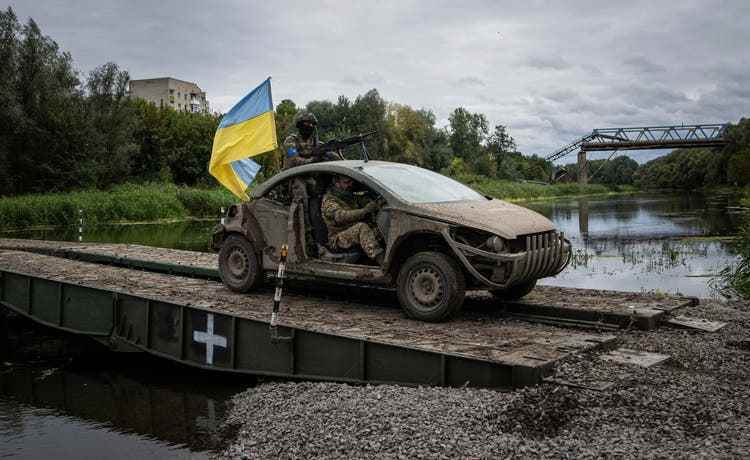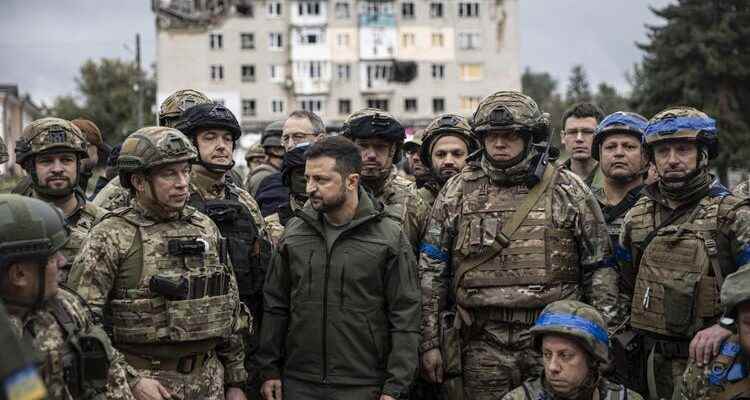The Ukrainians see the Russian partial mobilization as a step of desperation in the face of the catastrophic setbacks in the war. In the longer term, however, some see a serious danger.
President Volodymyr Zelensky on his surprise visit to the liberated city of Izyum in mid-September.
After seven months of war, Russia’s partial mobilization fails to shake Ukraine. Politicians and the media in Kyiv have reacted with demonstrative calm to the Kremlin’s announcement. It represents a sign of weakness, is the interpretation in both the Ukrainian capital and Western capitals. Putin’s war adventure failed said President Volodymyr Zelensky on Wednesday. “Now he wants to drown Ukraine in blood, but also in the blood of his own soldiers.”
The mobilization was an act of desperation in view of more than 50,000 dead Russian soldiers and the deep motivation of the fighting troops. “Why does Moscow need 300,000 reservists for when the losses are only 5,000 men?” asks the operator of the popular Telegram channel Informator with relish, alluding to the figure given by Russian Defense Minister Shoigu on Wednesday. The office of the Ukrainian president consistently speaks of Putin’s strategy of “Mogilisazia” – a play on the Russian word for mobilization, which could be loosely translated as “funeral”. The newcomers are referred to as cannon fodder.
strategy of deterrence
Partial mobilization, Kyiv was convinced, would solve neither the Russians’ serious supply problems at the front nor the technical inferiority of their weapons. The former deputy interior minister and activist Anton Gerashchenko, who is influential on social networks, predicts the same fate that Ghadhafi and Milosevic suffered for Putin with his “gamble”. Russia is now threatened with conditions like those after the lost First World War in 1917, he speculates: “Bloody battles, turmoil and civil war.”
Admittedly, more analytical voices also point to the domestic political risks of partial mobilization, which is now bringing the previously distant war into the center of Russian society. However, they see Putin’s move primarily as an attempt to at least stabilize the situation after a series of catastrophic setbacks.
The coincidence with the announcement of “referendums” in the occupied areas of southern and eastern Ukraine is no coincidence. Rather, the Kremlin is trying to increase the pressure on Kyiv with the threat that an attack against “New Russia” will be considered an attack against its own Territory scored and possibly answered nuclear. The additional soldiers at the front represented the second element of deterrence. “The aim is a tactical one”, writes commentator Ivan Primachenko. “Hold the front until the end of 2023, give Putin time to freeze the conflict or reach a diplomatic agreement.”
These goals would be more modest than previously articulated. But President Volodymyr Zelensky noted that despite the “noise” from Moscow, referendums and troop deployments are nothing new. From Kiev’s point of view, even the partial mobilization represents only an extension of similar but “covert” practices that have already taken place, for example in occupied areas. Ukrainian priorities remain the same, according to Zelensky: “More support for the Ukrainian armed forces and for everyone involved in gradually restoring our territorial integrity.” Kyiv even hopes that the new escalation will increase the West’s willingness to deliver arms.
Exposed Ukrainians
However, behind the Ukrainian coolness there is concern about the long-term consequences of Putin’s decision. “We can expect an escalation of the armed conflict, and we have to prepare for it quickly,” writes political scientist Volodymyr Fesenko, who is close to Zelensky. The Russians must now make a choice, adds his colleague Olexi Melnik: either the new recruits would be immediately thrown into the fray and effectively become cannon fodder. Or they initially received a one- to two-month training course. “This would be a serious danger,” he writes. “Despite their low quality, they represent a large number of new fighters.”
Partial mobilization is therefore likely to put more pressure on Ukraine in the medium term than its official representatives admit in their fearless speeches. Although their troops have celebrated spectacular successes against the aggressor in recent weeks, they are now confronted with a front that is more than 1,000 kilometers long and not very solid, on which their own positions in the liberated areas first have to be consolidated.
In addition, the fighting since February and the counter-offensive of the last few weeks have also resulted in losses for Ukraine. It remains to be seen what effect this will have on their ability to react quickly to another massive Russian deployment. In a way, with the partial mobilization Moscow has followed a step that the Ukrainians had already taken at the beginning of the war: At that time they called up their reserve with military experience – but a reserve that, after eight years of war in the Donbass, has significantly more experience than the Russians who are now being sent to the front from peacetime.

